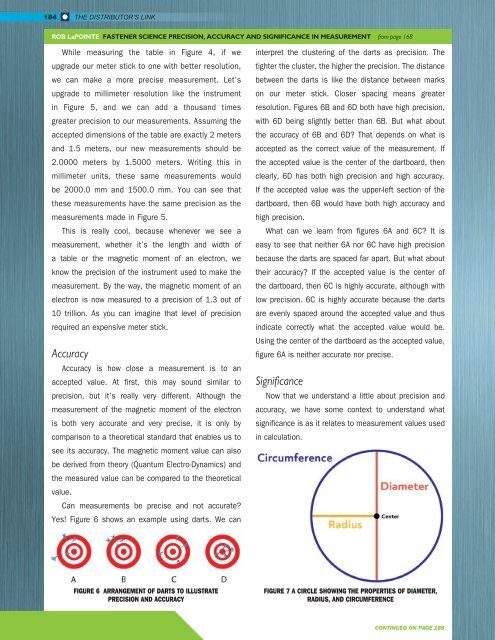FALL 2023
Distributor's Link Magazine Fall 2023 / Vol 46 No 4
Distributor's Link Magazine Fall 2023 / Vol 46 No 4
You also want an ePaper? Increase the reach of your titles
YUMPU automatically turns print PDFs into web optimized ePapers that Google loves.
184<br />
THE DISTRIBUTOR’S LINK<br />
ROB LaPOINTE FASTENER SCIENCE PRECISION, ACCURACY AND SIGNIFICANCE IN MEASUREMENT from page 168<br />
While measuring the table in Figure 4, if we<br />
upgrade our meter stick to one with better resolution,<br />
we can make a more precise measurement. Let’s<br />
upgrade to millimeter resolution like the instrument<br />
in Figure 5, and we can add a thousand times<br />
greater precision to our measurements. Assuming the<br />
accepted dimensions of the table are exactly 2 meters<br />
and 1.5 meters, our new measurements should be<br />
2.0000 meters by 1.5000 meters. Writing this in<br />
millimeter units, these same measurements would<br />
be 2000.0 mm and 1500.0 mm. You can see that<br />
these measurements have the same precision as the<br />
measurements made in Figure 5.<br />
This is really cool, because whenever we see a<br />
measurement, whether it’s the length and width of<br />
a table or the magnetic moment of an electron, we<br />
know the precision of the instrument used to make the<br />
measurement. By the way, the magnetic moment of an<br />
electron is now measured to a precision of 1.3 out of<br />
10 trillion. As you can imagine that level of precision<br />
required an expensive meter stick.<br />
Accuracy<br />
Accuracy is how close a measurement is to an<br />
accepted value. At first, this may sound similar to<br />
precision, but it’s really very different. Although the<br />
measurement of the magnetic moment of the electron<br />
is both very accurate and very precise, it is only by<br />
comparison to a theoretical standard that enables us to<br />
see its accuracy. The magnetic moment value can also<br />
be derived from theory (Quantum Electro-Dynamics) and<br />
the measured value can be compared to the theoretical<br />
value.<br />
Can measurements be precise and not accurate?<br />
Yes! Figure 6 shows an example using darts. We can<br />
interpret the clustering of the darts as precision. The<br />
tighter the cluster, the higher the precision. The distance<br />
between the darts is like the distance between marks<br />
on our meter stick. Closer spacing means greater<br />
resolution. Figures 6B and 6D both have high precision,<br />
with 6D being slightly better than 6B. But what about<br />
the accuracy of 6B and 6D? That depends on what is<br />
accepted as the correct value of the measurement. If<br />
the accepted value is the center of the dartboard, then<br />
clearly, 6D has both high precision and high accuracy.<br />
If the accepted value was the upper-left section of the<br />
dartboard, then 6B would have both high accuracy and<br />
high precision.<br />
What can we learn from figures 6A and 6C? It is<br />
easy to see that neither 6A nor 6C have high precision<br />
because the darts are spaced far apart. But what about<br />
their accuracy? If the accepted value is the center of<br />
the dartboard, then 6C is highly accurate, although with<br />
low precision. 6C is highly accurate because the darts<br />
are evenly spaced around the accepted value and thus<br />
indicate correctly what the accepted value would be.<br />
Using the center of the dartboard as the accepted value,<br />
figure 6A is neither accurate nor precise.<br />
Significance<br />
Now that we understand a little about precision and<br />
accuracy, we have some context to understand what<br />
significance is as it relates to measurement values used<br />
in calculation.<br />
FIGURE 6 ARRANGEMENT OF DARTS TO ILLUSTRATE<br />
PRECISION AND ACCURACY<br />
FIGURE 7 A CIRCLE SHOWING THE PROPERTIES OF DIAMETER,<br />
RADIUS, AND CIRCUMFERENCE<br />
CONTINUED ON PAGE 189
















